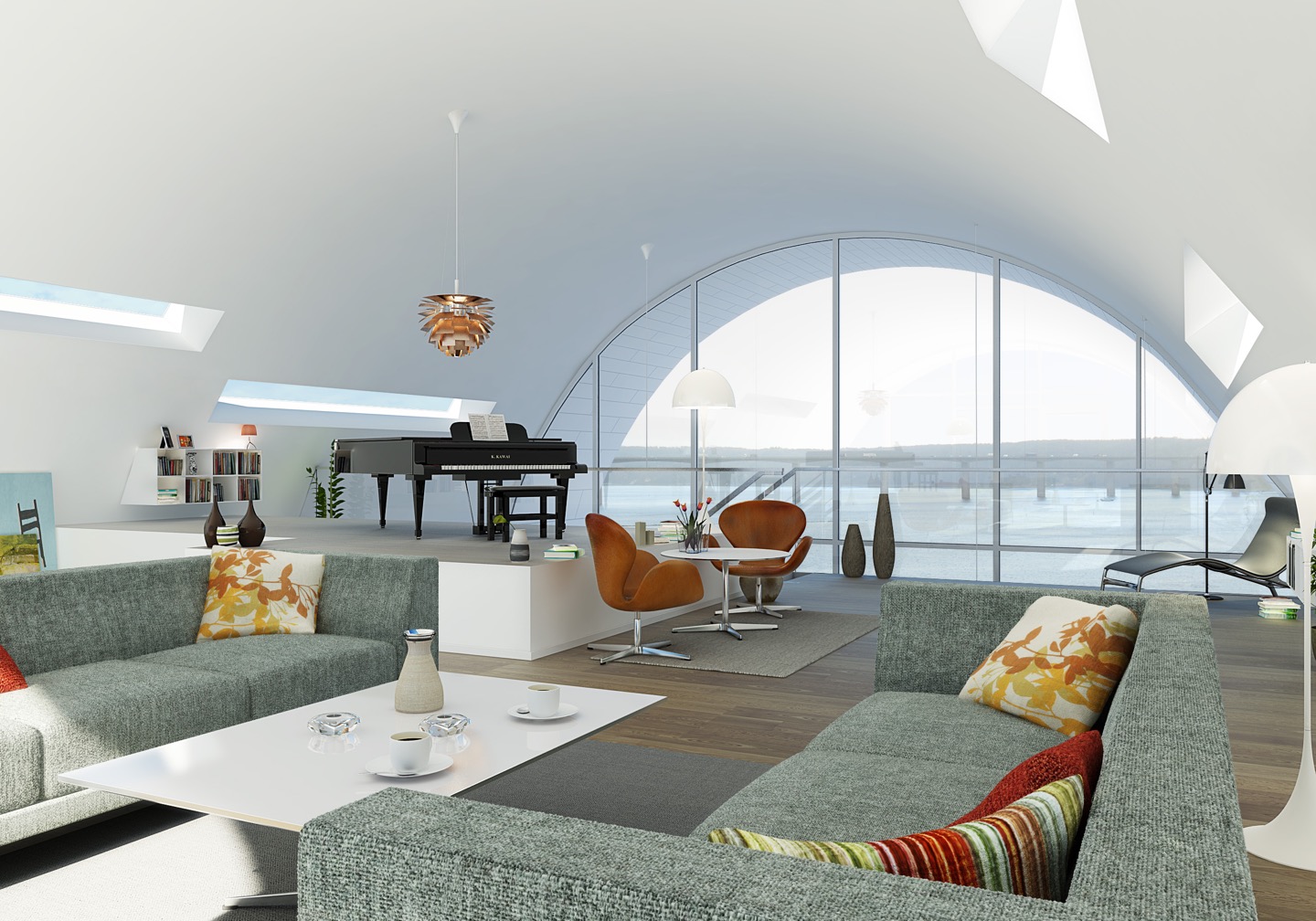Danish North Sea Nature Park. This 22,500-hectare park extends 45 km from Nymindegab to Blåvand and then 12 more kilometres south to Skallingen in the Wadden Sea NP. Beaches, sand dunes, and sandy heaths extend to interior plantations of coniferous and deciduous trees. Deforestation began in the Middle Ages and hastened the sand drifts that smothered fields, towns, and forests. The drifting has been checked by lyme grass and trees. A large population of about 4,000 red deer lives in the park. The small city of Varde (pop 13,000) serves as the transport hub of the area.
Blåvandshuk Lighthouse. Climb the 170 steps of this 39m lighthouse for panoramic views of sand flats, dunes, and wide sandy beaches. The light can be seen for 50-60kms at sea. Horns Rev 1 and 2, one of the world’s largest offshore wind farms is visible. Concrete bunkers from WWII litter the beach and dunes. This is the westernmost point of Denmark
ESBJERG (pop 72,000)
The port city has a 12km long harbour filled with industry. Originally the port was 250m long, built in 1874 for the export of cattle and pigs, fishing blossomed in the 1890s with 700 fishing vessels in 1970, but few are left now. Made big and rich from North Seas oil since 1973, it is Denmark’s only offshore city. In the last 20 years, wind energy has supplemented the oil.
Tarp Bunker Museum. This is one of the worst sites in the NM “Things to do” series – a WWII German concrete bunker with little to see. It is accompanied by a host of kitschy additions like a camo cannon, wood barricades strung with barbed wire, an old German bicycle and a camo wire netting that I presume is the tarp. It is only open on Sunday afternoons and then I doubt anyone visits.
Esbjerg Museum. This museum is primarily about the period 1940-45 when Esbjerg was a strategic hub for the German occupation forces. It had the only harbour on the west coast of Jutland that could be used in the event of an Allied invasion. About 1,200 bunkers were built in the Esbjerj and Fanø Island area. The museum moves through the house of one family in 1943. The son was in the resistance.
There is also an exhibit on Esbjerg from 1900-50 with reconstructions of a square, the harbour, a working-class flat, and a manager’s flat. DK50
The Fourfeldt Gravlund has 1,150 Allied airmen, German soldiers, and 151 German refugees buried in Scandinavia’s largest war cemetery.
Esbjerg Kunstmuseum. In a building designed by Jan and Jørn Utzon that also contains the 1100-seat Performing Arts Centre, this art museum shows modern Danish artists from 1920 to the present. The Aesthetic Laboratory allows visitors to experiment with colours, illusions, and optical tricks. For information on present exhibits go to www.eskum.dk.
Lightship Museum. In the harbour behind some buildings is the touristry part of Esbjerg harbour with craft tents and restaurants. In the water is the Lightship, a 1914 boat stationed in waters where the depth excluded fixed lights, has a lighthouse in the middle. There were 25 lightships stationed in 20 stations with the last off Mons in 1988 when satellite navigation systems started.
The entire boat is accessible with its 6 sleeping cabins, bathrooms, kitchen, engine room and decks all interesting. Free
Mennesket Ved Havet (Man Meets the Sea). This monumental sculpture consists of four, white, 9m-high “men” sitting next to the water about 3kms north of the centre. It was built on the occasion of Esbjerg’s 100th as an independent municipality in 1995. The sculpture portrays the meeting between pure, unspoiled mankind and nature. It has become a local landmark as it can be seen 10 km away.
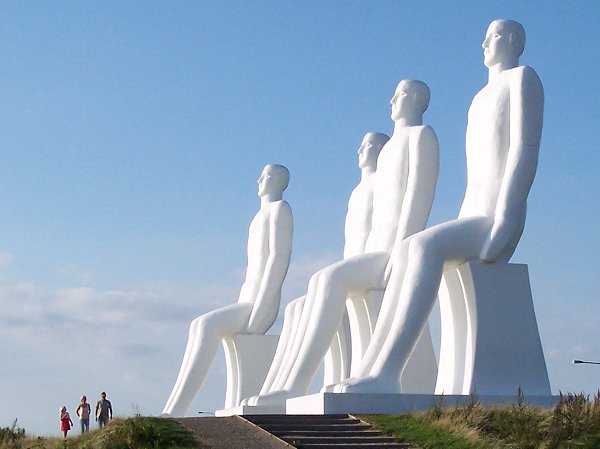
FANØ ISLAND (pop 3500)
Accessed by ferry from Esbjerg, the entire 16km-long island is part of Wadden Sea NP and a major tourist destination. In the late 19th century it had the largest fleet outside Copenhagen and saw the construction of over 1000 vessels in 150 years. It has seals, and birds, a 12km beach on the west side, and a nature reserve in the centre of the island.
Sønderho on the south tip has a windmill, in the NM “windmill” series.
I didn’t go here as the ferry was very expensive.
WADDEN SEA NATIONAL PARK (National Park Vadehavet). This is Denmark’s largest national park at 1,459 km2. With its salt marshes, it is among the most valuable wetland areas in the world and crucially important to breeding birds, fish, ocean mammals, and plant life. The tide moves a billion cubic metres of water through the sea four times a day creating mudflats and sand flats. Along with the high volumes of nutrient-rich freshwater flooding from the extensive network of streams and channels, this provides a huge larder for the 12 million birds migratory birds pass through yearly, crustaceans and seals.
This Unesco World Heritage body of water extends 500 km south to the Netherlands. The Dutch/German portion was declared in 2009 and the Danish part recently. Seals live on the sandbanks to enjoy the sun at Koresand, south of the island Mandø, or Langjord at Sanderho on Fanø Island.
RIBE (pop 8200)
31 km south of Esbjerg, the cobblestone streets date from 869 making it one of Scandinavia’s oldest and Denmark’s most attractive towns. It is full of half-timbered, 16th-century houses near the harbour and streams. Hovedengen is the meadow that fronts the town and part of Wadden Sea NP. In the 1500s, the cut-off heads of convicts were displayed here. The area was prone to floods, the worst in 1634 and a sea dyke with a lock was built in 1912.
Ribe Domkirke. Dominating Ribe’s skyline is this church with 3 distinct periods of construction. The old red-brick section dates to 948 making it the oldest in Denmark. Even the two towers are of different construction. Inside it has a wooden St George and the dragon, walls covered with grave slabs dating to the 1600s, pews with carved scrollwork and painted columns.
RØMØ ISLAND. Reached by a long causeway, this island is one of the tourist meccas of Denmark. The main centre is Lakolk with shops, fast food, a huge campground and close access to the west coast beaches. The German border crosses the channel south of Rømø.
From Rømø, I drove 125 km across south Denmark to Sønderborg and slept at a McDonald’s.
Day 6
I had planned on going to Germany to do some business but it was Sunday and everything is closed in Germany on Sundays. So I had an easy day of writing these posts and visiting the sites in the Sønderborg area.
SØNDERBORG
This is the largest city in South Jutland. The main part of the city is on the island of Als. Dybbøl is on the mainland side – the museum and windmill are both there.
Sönderberg Museum. This museum recreates a fort from 1864 when the Germans attacked Dybbøl in April and defeated the Danes. Later that year they attacked Sönderberg across the strait and also took control of it. They then controlled this area of southern Jutland (North Schleswig) until 1920 when a referendum was held and the locals voted overwhelmingly to join Denmark. In the fort behind wood palisades, there are 3 films (all in Danish) and the recreated barracks, post office, smithy, field kitchen, cannon, powder magazine, blockhouse, drill ground, and much more. DK120
Dybbøl Molle. The first mill was built here in 1745 to produce flour. It burned down in 1800, 1849, 1864, and 1935 but was rebuilt each time. The 1849 and 1864 fires were the result of wars with Germany. In the 1935 rebuild, it changed from wheat to grind corn. This is a cap mill where only the top turns so that the sails point into the wind. A wind vane automatically turns the mainsails.
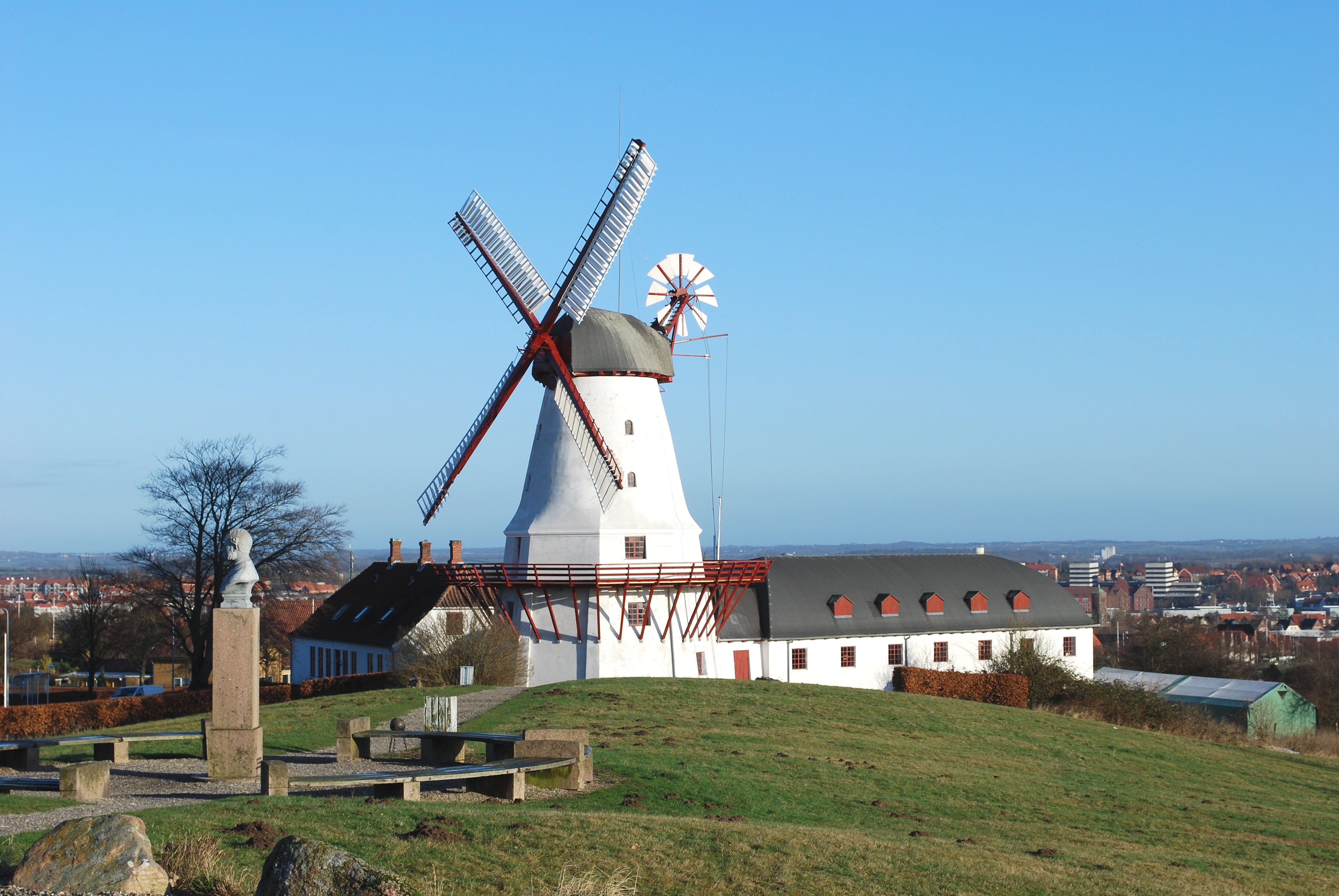
The museum associated with the windmill tells the stories of the wars here in 1848-49 and 1864 and the periods up to when the area was reunified with Denmark. The windmill has become a symbol of Danish identity as the mill owners played a significant role in both wars and the mill was rebuilt each time it was destroyed.
The museum and windmill are on the top of Dybbøl Hill, the high point on the mainland for miles around and across the strait from the main part of the city of Sønderberg. The hill has been the site of graves, and war memorials and has the outline of the original fort from 1864. The Germans built a large war memorial to commemorate the 1864 win completed in 1872 and the area was a significant destination for German immigrants after a German naval base was built here in 1906. The memorial was destroyed in 1945 by the Danish resistance. Some of the bas-relief panels from it are in the windmill.
Sönderborg Slot (Castle). This large square, 3-story brick castle dates from the 15th century. When canon became common, 2 cannon bastions, ramparts, a moat, and a drawbridge were added in the 1530s. The building returned to being a castle, and eventually a baroque palace. It sits on a small peninsula jutting into the harbour and none of those fortifications remain. Enter on the east into a large central courtyard and visit the kitchen, bakery, guardroom (from 1400 the only medieval room preserved), dungeon, banqueting hall, tapestry room, and chapel (from 1568, it is the oldest Protestant chapel in Scandinavia.
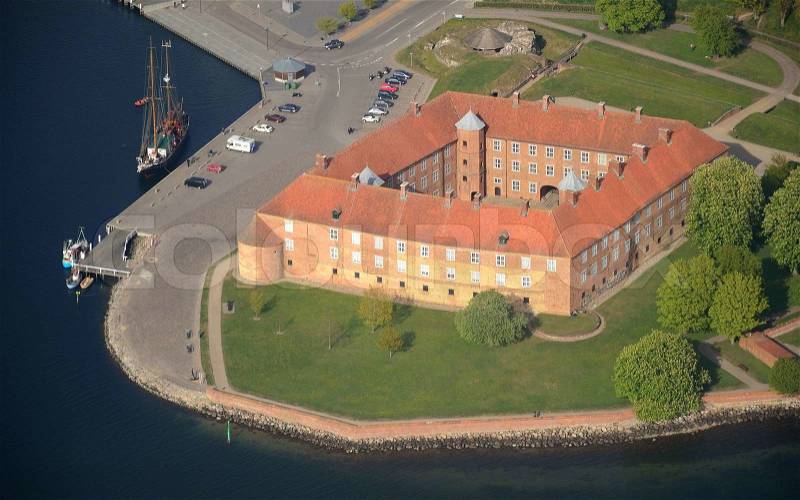
Other exhibits cover the history of the castle, city (Sönderborg has a Prussian and Danish history), and Southern Jutland (Schleswig wars from 1848 to 1920 and reunification in 1920). Art includes West Schleswig wood carvings, medieval church art and a gallery exhibiting paintings given as gifts by Danish artists after 1920. DK80
Augustiania Sculpture Park. In Augustenborg, about 8kms NE of Sondenborg, is this eclectic park sitting in a lovely grove of big trees behind a large theatre. All by different artists, mostly Danish, the highlights for me were Den Gravid Teenager (a naked pregnant teenage woman nailed to a high metal cross) and a circle of granite seats with books for seats. Free
Day 7
I was up early and driving to get to Flensburg Germany where I had a lot of business and shopping to do – hoping to save with cheaper German prices.
Gråsten Palace Garden. This is one of Denmark’s national palace gardens originally linked to Queen Ingrid, the mother of Queen Margrethe II. The slot (palace) is still used by the royal family as a summer residence. The regiment changing of the guard ceremony occurs daily – they march from the mansion at Ahtefeldvej at 11:30 and march to the accompaniment of flutes and drums to the palace. It is a grand 2 and 3-story, white palace with a bell tower surrounding a lawn on three sides. There’s no access to the palace itself but the chapel can be visited. Originally built in 1603, it was added onto in 1757. A lake sits behind the building and ponds surround the outskirts.

The garden was originally baroque but changed to a romantic landscape garden with many flower beds, an apple orchard (the Gråston apple is Denmark’s national apple), lawns, an old oak tree (under which HC Anderson wrote), and a lovely sunken rose garden surrounding a small pool with a fountain. There is a swimming pool and tennis court. It is about 20 km west of Sønderberg.
Flensburg Germany. I arrived at the Volkswagen dealer at 8 am when it opened, had a drive around to find the dealer with the part I needed, and then struggled for 2 hours to fix it on my own before a very nice mechanic did it in about 10 minutes – for free! This is very unusual for a car dealership.
I shopped for a whole lot of things I needed, bought gas and groceries, and was finally on the road back to Denmark at 13:30 before I needed a nap – not a very productive sightseeing day.
CHRISTIANSFELD MORAVIAN COMMUNITY
This small town became a Unesco World Heritage Site in 2015 – it began as a Moravian community in the 18th century.
History. The Moravian Church can be traced back to 1415, when the evangelical people of Bohemia and Moravia (in the present-day Czech Republic) united, after their leader, Johan Hus was burned at the stake in Konstanz for trying to start his own reformation of the Catholic church. In 1457, these people assembled in the town of Kunwald in Bohemia as a united brotherhood – the adult members called themselves “brothers” and “sisters” – and by the 16th century, totalled 200,000 members. The Moravian community was almost totally destroyed in religious wars between 1618-48.
The remaining members survived by migrating principally to Saxony Germany (and other places). A Moravian community was established in Hernhut on the land of Count Nicolaus Ludwig Zinzendorf (Hernhut means both “under the protection of God” and “keeping watch for the Lord”) and this is where the name “Hernhutters” stems from. Zinzendforf became the head of the re-established Moravian Church. After he died in 1760, the Hernhutters founded Moravian towns in many countries and became an international missionary church. They were skilled craftsmen and traders.
In 1766, Christian VII became king of Denmark. One of his cabinet ministers was interested in attracting trade, crafts, and industry and invited the Moravians to move to Denmark where they bought the Tyrstrup Farm in 1771 for 1041 rix-dollars. King Christian gave a generous concession to establish a Moravian town there in 1772 granting free religious practice, tax concessions, no customs duties, its own court, no military service, no compulsory membership of guilds, and money to build the town. Christiansfeld means “Christian’s field”.
A town plan was drawn up in the same design as Moravian towns in other countries: two parallel streets united by a church square around which the most important buildings were built. In April 1773, the foundation stone was laid for the community’s first house of worship, the vicarage, principal’s house, and a hotel for friends and family and was ready for occupation by August. The church was inaugurated in November. Three wings were added to the church in 1777 and 1796-7. Most of the community was constructed by 1783 for 100,000 rix-dollars, an impressive sum for the time. All the buildings are cream-coloured brick and have white window frames and Hansard roof gables.
Moravian Church. This is the central point of Christiansfeld’s old buildings – larger, taller, and roofed in black tiles, whereas the other buildings have red roofs.
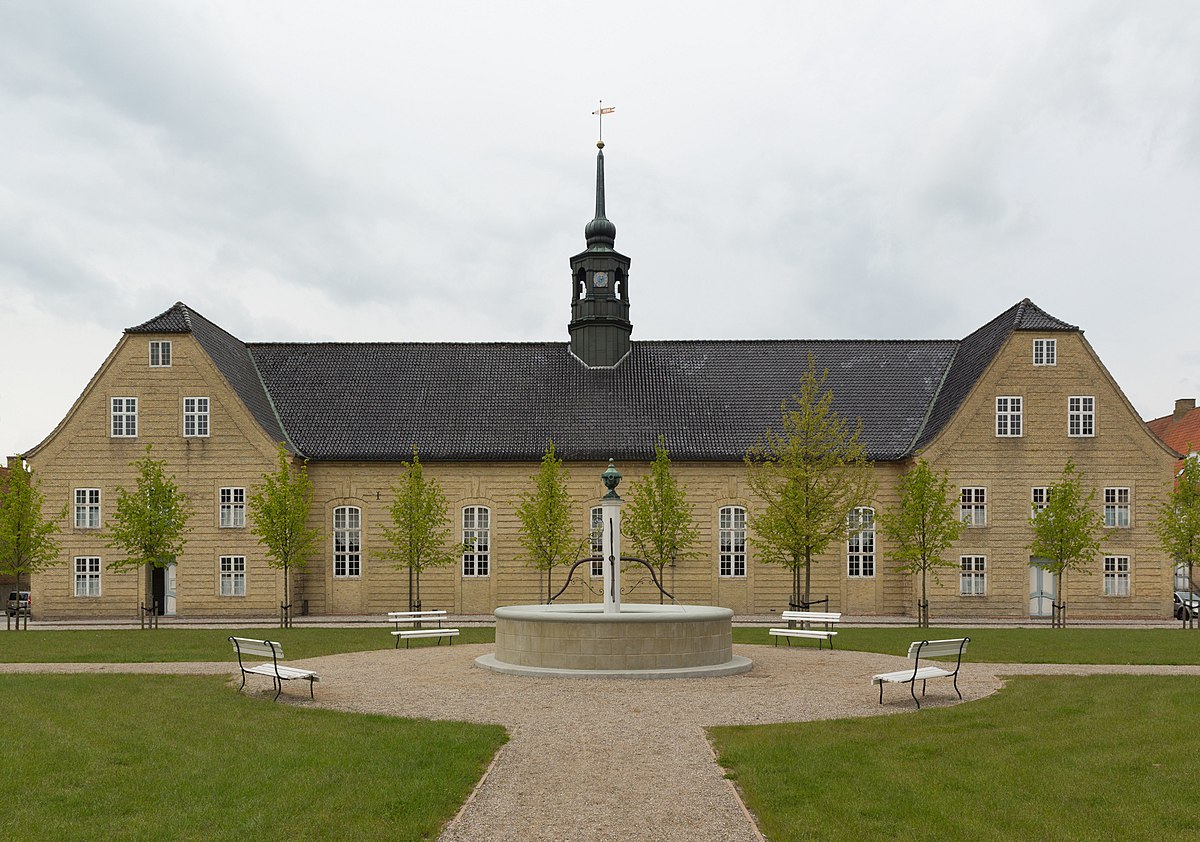
It is the largest building without supporting columns in Denmark and is characterized by great simplicity – almost everything is white, the walls, ceiling, and pews – sand-covered floors of broad planks of Douglas fir and 10 hand-forged chandeliers that hold candles and dating from 1777. The space holds approximately 1000 people although it is only full on special occasions like Christmas Eve. It contains no altar, but instead, a liturgy table covered in a green cloth embroidered with the symbol of the church, a lamb holding a Danish flag and a Moravian cross – the priest conducts the service and administers the sacraments here from a large, high-backed white chair.

Choirs and Houses. The Moravian church divided its members into “choirs”, each with its own form of economic independence and house and each with its own church room used for daily worship, a dormitory and dining hall, and its own small plot of land for growing vegetables and gardens with arbours. The Church provided a social support system similar to that provided by public service now.
The Brother’s House had workshops for cabinetmakers, furniture makers, coopers, and bakeries. It was here that the unmarried “brothers” received their education and lived. Today, this house has ordinary living apartments. The Sister’s House had laundry, weaving, spinning, and knitting workshops and was where young girls were educated in language and womanly pursuits such as needlework and housekeeping. Today, it is the Cultural Heritage, Art and Science Centre and houses the Chrisiansfeld Centre, Museum, the Local History Archive, the Moravian Danish Mission (HDM), a gift shop and Kolding Music School’s Christiansfeld department.
The Widow’s House was inhabited by single women and widows and now contains family apartments. Classic women’s dress consisted of a cotton caftan, woolen shirt, lined skirt, apron, wool shawl, and capote.
Boarding Schools. In 1784, a boarding school for girls was built and four years later one for boys to house students from many different countries. They had a good reputation for education and practiced the pedagogic thinking of Amos Comenius. Today, the Girl’s School has the library and music school and the Boy’s School is part of the Christiansfeld School.
Economy. The brothers were hard-working, skilled craftsmen, traders and industrial men who created manufacturing enterprises. The first businesses were a hotel, chandlers, dye works, cigar and tobacco factory, a piano factory, rope manufacturing, milliners, printers, bookbinders, and a honey-cake factory. Today only the bakery, hotel and stove makers are still owned by the Moravian Church.
Today. The town centre remains untouched, exactly as it was around 1800 when the Choir Houses were completed. 36 houses are listed in the European Listed Buildings. The most striking feature of the buildings is the wonderful, large plank floors. The grass square has an unusual fountain. The streets are all cobblestone and the sidewalks are finished granite.
The Moravians are a free Evangelical-Lutheran congregation with a confession of faith that doesn’t contradict the Church of Denmark. Its origins remain in Hernhuttian pietism – the inspiration for its liturgy and preaching stressing simplicity and equality of all members. The Moravian Church is connected with Moravian churches throughout Europe, the USA, and missions that span the world (Tanzania has a large mission for example).
Today the Christiansfeld congregation has 345 members with about 135 living in the town – most are active in the church contributing to the life of the church throughout the year. The verger hands out hymnbooks and serves tea and rolls during the Kælighedsmáltidet (the Celebration of Faith) held 2-3 times per year. Singing alternates between the congregation and choir while tea (with sugar and milk) and raisin rolls are served. The choir and a brass band participate in all church festivals. At services, a litany using prayer is conducted with the priest and congregation alternating in reading the text. About 200 of the congregation are active in missions around the world. The church lives on today carrying on its original motto of “Our Lamb has conquered; let us follow him”. All services and gatherings of the Moravian church are open to all.
Moravians are known for their unique, classic furniture design, especially chairs. In 1960, the chairs used by Nixon and Kennedy in their debates were “The Chair”.
KOLDING
Danish Museum of Nursing History. This museum is a few km east of Golding along the Kolding Fjord in a rural setting. The building was the Christmas Seal Sanatorium, a tuberculosis sanatorium for children opened in 1911. Initially built for 120 children, it expanded in 1917 with a pavilion that is now the museum. Tuberculosis was the major killer, causing ⅓ of all deaths in Denmark. It was a poor man’s disease especially tragic for poor children. The only treatment was good nutrition, regular exercise, rest and plenty of fresh air in an open shelter. Collapsing the involved lung using a pneumothorax was also used. On average, children were treated for about a year with an 85% success rate.
The prevalence significantly decreased by 1939 and the sanatorium was closed in 1959. After WWII, many of the children came from Greenland. The buildings became a centre for the care of the mentally deficient and it closed in 1970. One of the pavilions eventually became a 4-star hotel and this pavilion became the museum that opened in 1999.
The museum gives the history of nursing from the Catholic monasteries to today. The story is about women’s long struggle for education, reasonable working conditions and recognition in the labour market. It is of special interest to nurses and other health professionals. DK40
Trapholt Museum of Modern Art. This is housed in a wonderful space above the fjord. It has large spacious galleries, a long corridor with exhibits and a round gallery exhibiting the furniture of Arne Jacobsen who designed many classic pieces especially chairs.
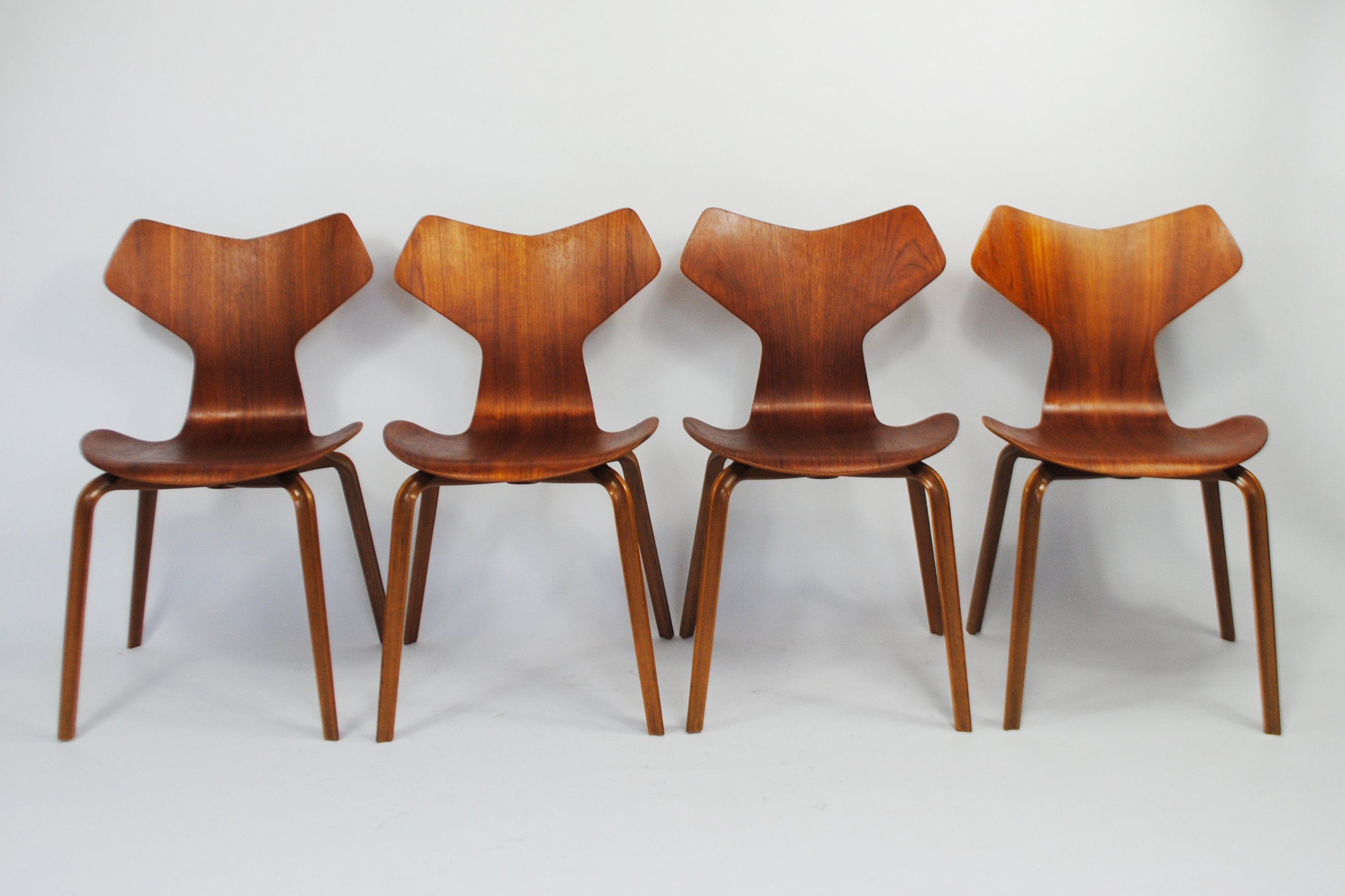
The furniture is definitely the highlight with other pieces by Hans Regner (The Chair used in the Nixon/Kennedy debate in 1960)

The Pantrin chair and Ray Eames 1956 Lounge Chair
But this is unlike most contemporary art museums with a lot of bad art. There are ceramics (Louise Hindsgavl), geometric abstracts (Richard Mortensen), and mixed media collages (Kirstene Roepstorff). DK120


JELLING VIKING MOUNDS, RUNIC STONES AND CHURCH
Vikings attacked Scotland and England, Normandy, the Mediterranean in Spain, Sicily and Italy, the Middle East, and the Russian river valleys. There were two original Viking raiders: Krigeon the Warrior who targeted monasteries and churches as they had many valuables and priests and nuns were unarmed. Rollo ravaged Normandy, part of which was given to him by the French king to keep other Vikings out. Vikings settled in Greenland and were the first Europeans in North America when Lief the Lucky visited Newfoundland in 1000.
From 979-81, Harold Bluetooth constructed 5 ring fortresses: Frykat (Jelling) and Aagersborg (240m diameter ring on the Limfjord, many expeditions sailed from here) in North Jutland, Nonnenbakken on Funan (now under the center of Odense), Trelleborg on Zealand and Borgeby in Sweden. This was the start of the unification of Denmark when it went from a Nordic pagan society to a European Christian civilization. Large estates were built and the first towns were established.
JELLING
Kongernes Jelling – Home of the Viking Kings. This museum is part of the Denmark National Museums. It is full of multimedia presentations that tell the exciting story of the Viking monuments here. Only the mounds are left of the original site. Free
Bluetooth technology is named after Harald Bluetooth. The logo is the runes H and B on top of one another – H for Harald and B for Bluetooth.
Jelling served as the royal seat for the first two kings of Denmark. Gorm the Old was the last pagan Viking ruler and lived at Jelling in Jutland. He was married to Thyra. Their eldest son Canute died in Ireland on a raid. Their second son, Harald Bluetooth, became king in 959. Descendants of Gorm and Harald have ruled Denmark ever since.
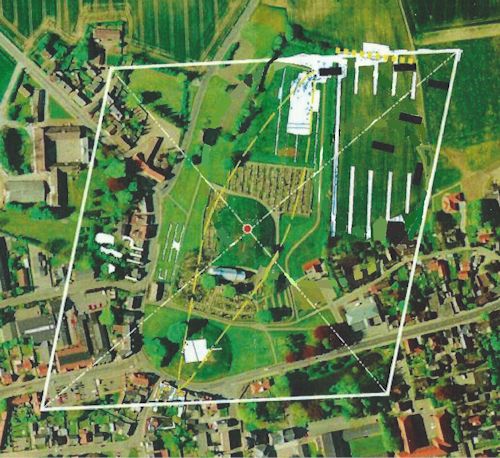
Stone Ship. This lay in the area before the church and the mounds and Jelling were built around it with the North Mound in its center, which is about 350m long and built to create an important sepulchral monument to Gorm the Old. It is the largest stone ship in the world. According to Norse mythology, the dead could sail in this ship to the gods in Valhalla. It is now marked by white concrete tiles. Beneath the raised tiles in the north end, stones from the original stone ship were found.
Gorm’s Stone. Erected in 950 by Gorm as a memorial to his wife Thyra. The inscription reads: Gorm king made these sepulchral monuments for Tyra his wife. The exciting part of the stone is that Gorm calls himself king making him the first sure king in Denmark’s list of kings, even though there are names of kings before him. Denmark is named for the first time on Danish soil on Gorm’s stone, more than 1000 years before the country got its name.
North Mound. In the exact centre of the palisade, it was 3m high. In the winter of 958-59, Old King Gorm died and it was decided that he should be buried in a chamber on the top of the low mound. In 1820, when building a well, local farmers dug into the mound and found it empty except for objects that showed it was no ordinary spot – there was a large oak chamber with a roof of 25 oak trees covered with large stones. For three years, 1.5 million turfs were transported to the mound. New excavations in 1861 and 1942 did not explain, but extensive excavations between 1976 and 79 in the church found under the church floor a Viking Age grave. From all appearances, Gorm the Old had been moved from the north mound into the newly erected building, probably a royal estate.
South Mound. 70m in diameter, it was 11m high and used 2 million turfs to construct. It is only a mound and has no chamber. It is thought that the purpose was only to make the large Jelling stone look more beautiful between two mounds.
Harald’s Stone. The larger stone was raised by his son, Harald Bluetooth in 965 to celebrate the conquest of Denmark and Norway and the conversion of the Danes to Christianity. It has three sides: one with an animal image, one with an image of the crucified Jesus Christ, and a third bearing the following inscription: King Haraldr ordered this monument made in memory of Gorm, his father, and in memory of Thyrvé, his mother; that Haraldr who won for himself all of Denmark and Norway and made the Danes Christian. For the first time, a Danish king declares himself a Christian. It is often given the nickname “Denmark’s birth certificate”. The image of Christ is also the oldest preserved in Scandinavia. The stone was originally painted and at the museum, you can see how it perhaps originally looked. But it still took several hundred years before the country as a whole was converted to Christianity. Even today we use the names of the old gods for the days of the week: tirsdag (Tuesday), onsdag (Wednesday), torsdag (Thursday) and fredag (Friday). Erected between the mounds, it weighed 10 tons.
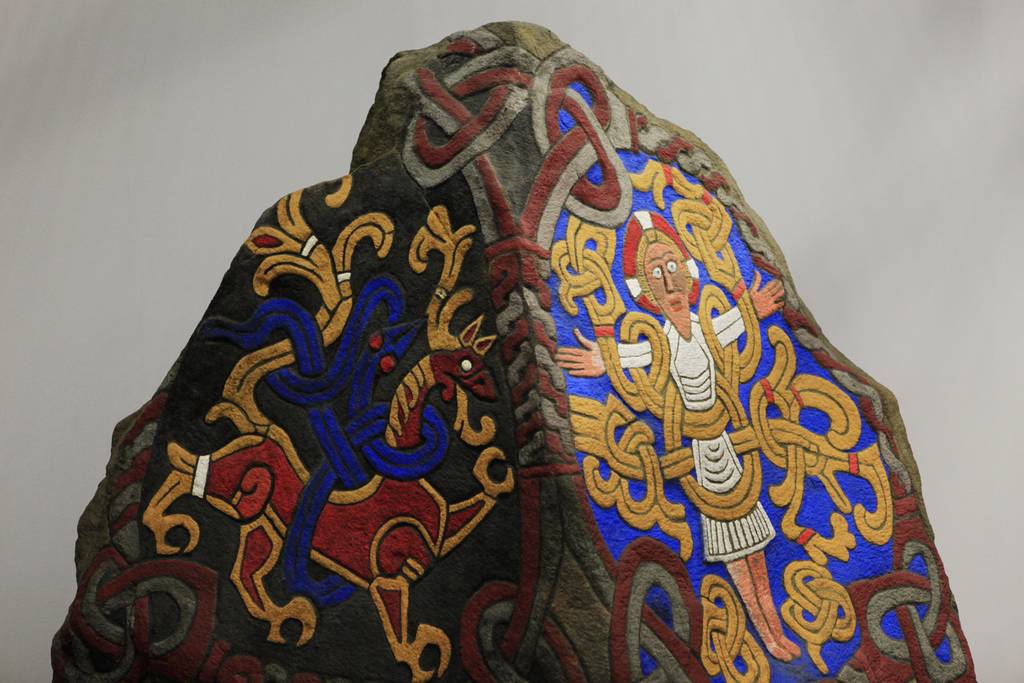
The crucifix on this stone embellishes the Danish passport.
Palisade. In 968, Harald built a 4m high, 1.4km four-sided palisade of solid oak in a trapezoidal shape encompassing 12.5 hectares, using 1100 old oak trees and 2300 young oak. Excavations in 2013 found the remnants of the palisade and the date of the trees. Today it is marked by white pillars.
Church. Probably originally a wood royal estate was built here but it burned down and was replaced by a travertine church – this is how Gorm ended up under the church floor. This church was larger than the present white church and for the Viking Age, must have been a unique size. Jelling Kirke sits next to the north mound and is now the hub of the parish with more than 4,200 residents. A small strip of silver in the floor marks Gorm’s grave.
Longhouses. The foundations of three have been found inside the palisade. Today they are marked by concrete surfaces.
North Gate. There are only traces of one small gate where two riders side by side could pass. It is suspected that a more impressive entrance was built elsewhere but is yet to be found.
Harald also extended the Danekirk, a defensive earthwork that had existed before, to 6.5 km. In 980, he built the bridge at Raving Enge across the widest section of Vejle Ada. It is 760m long and rests on 1,700 heavy oak pilings up to 6m in length. It was Denmark’s longest structure until the old Little Belt Bridge was built in 1935. Two of the bridgeheads have been reconstructed.
LEGOLAND BILLUND RESORT
Legoland Billund, the original Legoland park, opened in 1968 in Billund, Denmark. The park is located next to the original Lego factory and Billund Airport, Denmark’s second-busiest airport. Over 1.9 million guests visited the park in 2011 and since its opening, more than 50 million, making Legoland the largest tourist attraction in Denmark outside Copenhagen. The Legoland parks that have since been built are modelled upon Legoland Billund, most noticeably the Miniland area, which is made up of millions of plastic Lego bricks.
History. The first Legoland was built adjacent to the Lego factory that was founded by Ole Kirk Christiansen in 1949. His son, Godtfred, took over the family business in 1957 when his father died and just two years later he bought out his three brothers. In 1968 Godtfred decided to open a 14-acre Legoland Park to promote his toy business. The park became an instant success and has over the years added many original rides.
Today, Legoland Billund is the most visited tourist attraction in Jylland. Five other Legolands have been built in other parts of the world — Legoland Windsor Resort in 1996, Legoland California in 1999, Legoland Deutschland Resort in 2002, Legoland Florida in 2011, and Legoland Malaysia Resort in 2012. The Blackstone Group, an investment firm, bought a 70% controlling stake in Legoland in 2005, with the remaining 30% still owned by Lego. The parks are operated under the Merlin Entertainment banner.
Themed Lands
Mimi Land is the heart of any Legoland park. The 1:20 scale Lego brick models feature landscapes, sights, and buildings from all over Denmark, as well as famous landmarks from other parts of the world. These include, from Denmark: Amalienborg Castle, Nyhavn, Skagen, Klampenborg Station, Ribe, Billund Airport, Dybbøl Mill, Møgeltønder, and Lilleby, a fictional Danish village. In addition, there are famous landmarks from Sweden, Bergen in Norway, Scotland, Germany, the Netherlands, Kennedy Space Center, Mount Rushmore, Abu Simbel in Egypt, the Statue of Liberty, the Acropolis of Athens, and Star Wars. The Lego Top offers a nice view of the entire park. The structures were made using more than 25 million Lego bricks.
Duplo Land contains rides and attractions for young children. This zone contains the Lego Studio, a purpose-built 600-seat 4-D theatre, complete with special effects and a giant screen. Lego Atlantis by Sea Life was added in 2007.
LEGOREDO Town is a Western-themed land that contains the rides Lego Canoe, Legoldmine, Westernride, Timber Ride, and Legoldmine Train.
Pirate Land is a pirate-themed area.
Adventure Land. This area contains some of the park’s more exciting rides such as the wild mouse roller coaster, and X-treme Racers. Jungle Racers jet ski.
Lego City. Fluck Fire Brigade.
Knight’s Kingdom contains The Dragon Coaster and Viking’s River Splash.
Polar Land is a North Pole and South Pole theme area.
Attractions
Roller coasters. The Dragon, Polar S-plorer (65km/h with 5m free drop, X-Treme Racers (56km/hr), and Flyvende.
Water Rides. Lego Canoe – a log flume ride, Vikings River Splash – a 438 meter-long river rapids.
Other rides. Caterpillar – a Himalaya ride, Dive to Atlantis – submarine ride, Falck Fire Brigade – douse the fire yourself, Jungle Racers – water jet ski ride, Lego Atlantis – a sea life aquarium, Lego City – build your own Lego land in Lego City. Lego Studios – a 4D theatre with 3 movies, Lego Top – a 36 m Observation Tower, Lego Train – a themed 2-minute train ride, The Lighthouse – pull yourself up 9 m towers, Monorail, Nintendo Game Show, Penguin Bay – live penguins, Pirate Carousel – spinning cups, Pirate Boats – dark boat ride, Pirate Splash Battle, Power Builder – RoboCoaster, The Temple – dark ride laser shoot-out.
Kiddie rides. Several.
Special events. The park hosts many special events throughout the season, including a Halloween celebration, firework shows, and Star Wars days.
Accidents. On April 29, 2007, a 21-year-old female employee was killed by a roller coaster when she climbed over a security fence to retrieve a guest’s wallet.
Incredibly expensive at DK395 (375 concession) and DK50 for parking, I found this amusement park not exciting as it is really for children and many of the attractions are for little children. It is primarily rides – roller coasters, water slides, and toy trains all made out of large Lego blocks, unlike the little pieces my children played with.
Uldom Mölle. Built in 1895, this windmill is one of the few that still functions as a flour mill. When the wind isn’t blowing, a diesel motor operates the mill. It contains a small museum. It is northeast of Legoland. DK30
Horsens State Prison (Forsorgs Museum). Built in 1853 it held resistance members from 1943-45. There is an interesting collection of illegal hash pipes made from an astounding number of things. Many prisoners’ stories are told with Carl Lorentzen the star as he escaped in 1949. Exit the prison following the tunnel he dug. DK50
A friend of my children’s from BC lives in Horsens but he was too busy to see me – so much for Danish friendliness. I finally found a Laundromat and did my long overdue laundry.
Day 8
VEJLE
Vejle means ford – the city started on a small island in the wet river valley where it was possible to cross – that is where the city centre sits now, a long way from the harbor. It is prone to flooding and efforts have been made to control water movement through the town using canals, pools and lakes before being pumped into the fjord. Unusually, this city has decided to make all its museums free to the public, possibly the only city in the country to do so.
Culture Museum Spinderhallerine. This museum is in an old factory building as a cotton spinning mill was started here in 1892 and it powered Vejle’s industrial revolution – it once was called the Danish Manchester. The population of the town doubled by 1910. Foreign competition finally caused it to cease operating in 2000. A foundry also was a significant employer producing wood stoves, windows, and enamelled bathtubs – it closed in 1995. The museum displays the bog body of Haraldskær Woman, thought to be a murdered Viking queen, hence her nickname, Queen Gunhild. The display lists all the bog bodies uncovered in Denmark and Germany. Free
Vejle Kunst Museum. This small art gallery has graphics and drawings from around 1470, linocuts, abstracts by Egiel Joroben, a sculpture gallery and an artist’s interpretation of the war in Afghanistan. Free
Økolariet. In the centre of Vejle near the train station, this is a different kind of science center. In the permanent exhibition, walk on the bottom of the inlet or through the sewers of the city and test your skills at waste sorting. Learn about energy, biodiversity and edible insects. Free
Harbour Area. Pass a lot of construction to arrive at the completely renovated harbour with a marina for 600 boats and Fjordenhus – a very modern 3-story structure sitting in the water with some hanging geometric sculptures.
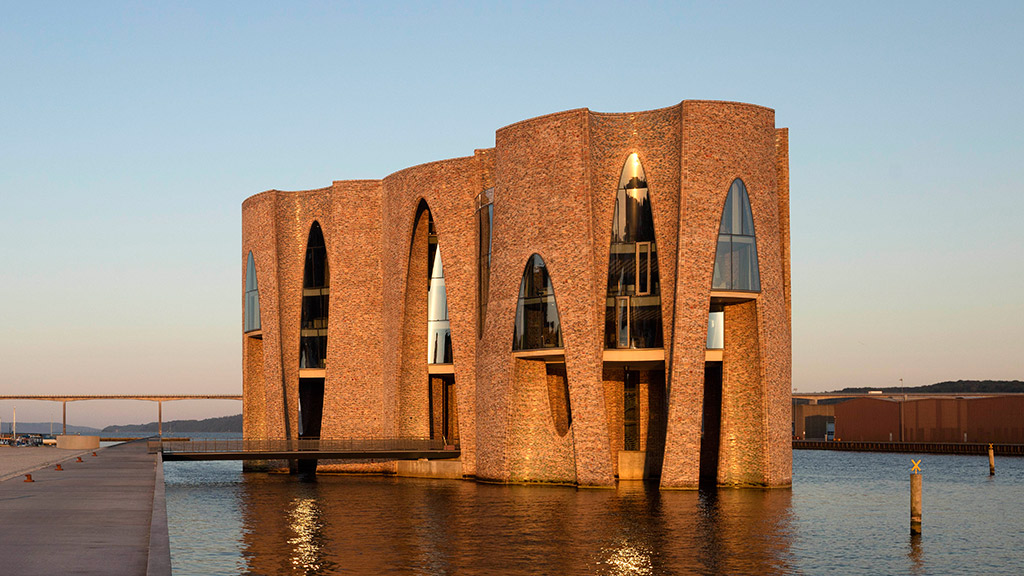 It was suggested I come here to see the Floating Art – an interesting exhibit by 11 artists and architects that places the pieces in the water of the harbour. Unfortunately, I couldn’t find it!
It was suggested I come here to see the Floating Art – an interesting exhibit by 11 artists and architects that places the pieces in the water of the harbour. Unfortunately, I couldn’t find it!
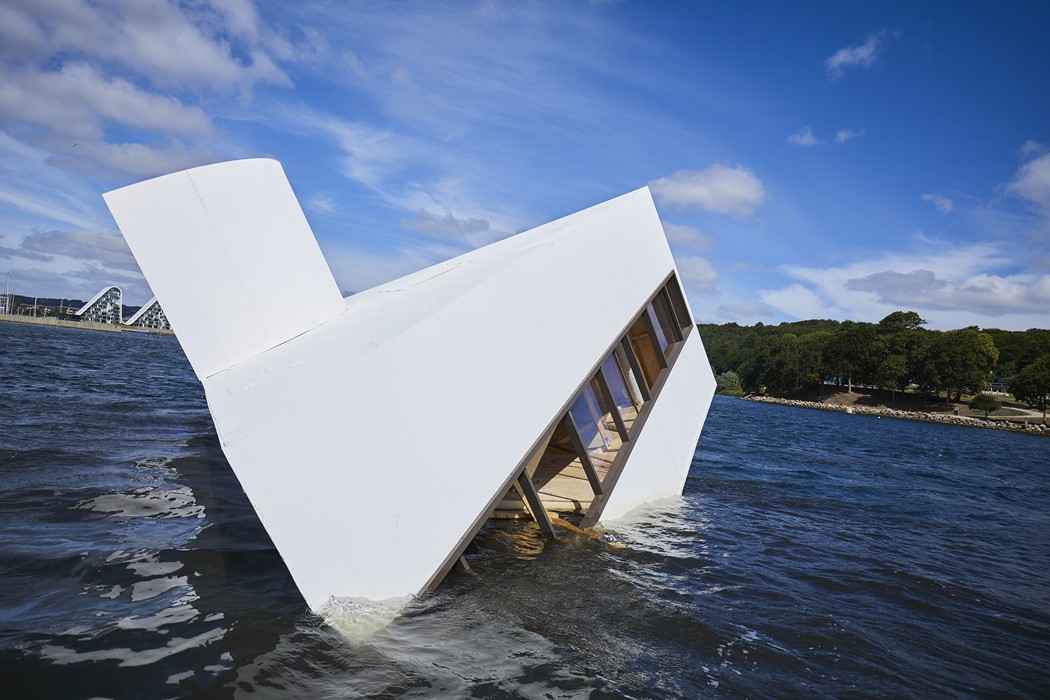
The Wave is a wonderful apartment complex of 5 buildings also sitting on the water.
